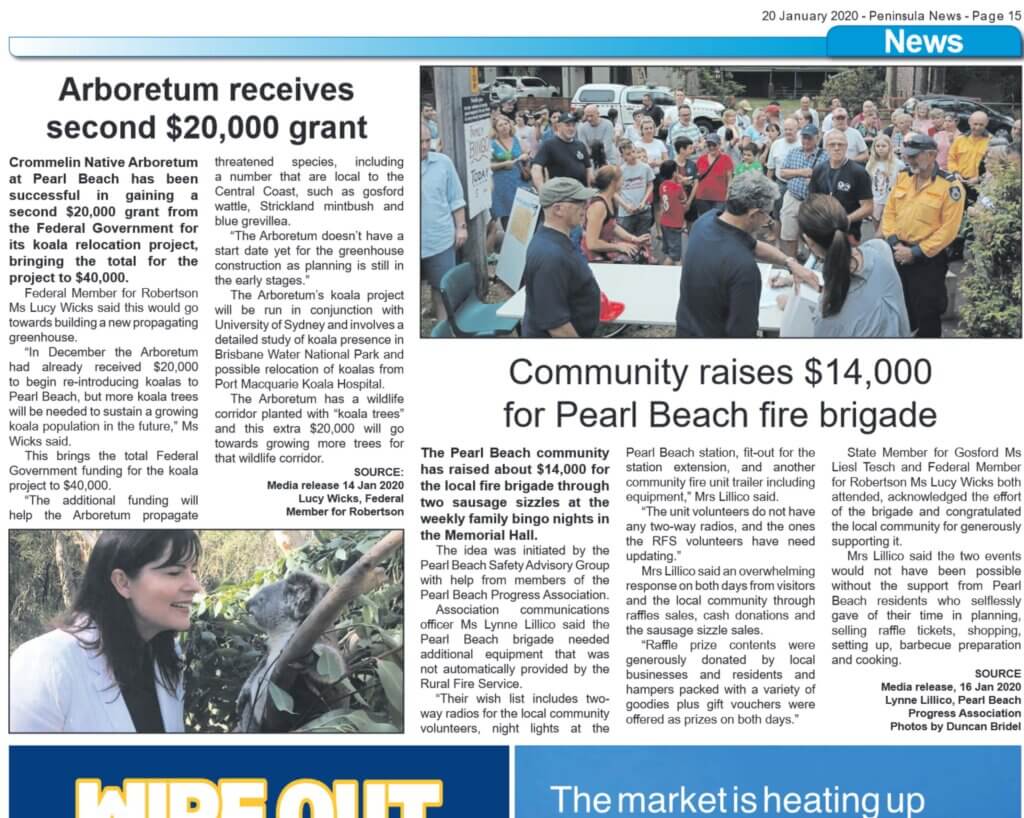RFS Rural Fire Service
Pearl Beach Rural Fire Brigade
Story of the Brigade
Bush fires were a major concern for the early settlers in Pearl Beach. The formation of a brigade to fight bush fires came very early and for many years was a significant reason for the continuing existence of the Progress Association which was formed in 1929.
In the early days the only water available for fire fighting was the water in the creeks, springs and wells and in private water tanks. Mostly the fire fighters cleared fire breaks using shovels, axes, hoes, mattocks and tried to beat out encroaching flames with green boughs cut from the trees, or beaters made of canvas or hessian attached to pieces of wood and fitted with handles. These beaters were soaked in water where possible to make them more effective. These were later supplemented by knapsack sprays.
The collection of fire-fighting equipment was stored in a shed on Minard Crommelin’s property, Minard was an early settler, and a staunch environmentalist,she made her shed available because, mostly fires came out of the bush probably as the result of a lightning strike. In the shed the equipment was close to where it was most likely to be needed. Ironically, because there was no electricity in Pearl Beach in those days, fire was used all the time for cooking, heating and lighting, but there was also a proper understanding of the dangers and ways of fire and it was treated it with respect.
The fire brigade was composed entirely of local volunteers who lived in the valley or were visiting for the summer holidays. At the first sign of a fire, an alarm was sounded summoning them to gather to fight it. There were not many vehicles available to transport them though some fire fighters possibly came on bicycles, others on foot.
Eventually in 1948 there was a disagreement between Miss Crommelin and the fire brigade – she wanted fires in the bush fought because she said frequent fires were changing the plant ecology, strengthening plants that thrived on fire and destroying those that were more fragile. The brigade preferred to focus on fires that threatened property and let fires in the bush burn themselves out.
An underlying problem seems to have been about whether the fire brigade was an autonomous body, or whether it came under the authority of the Progress Association, or the council. There may also have been a clash of personalities as Minard was a strong woman and she was living in a vulnerable place.
Eventually a public meeting was convened and on the advice of the Bush Fire Advisory Council it was decided to leave fire fighting in the hands of the locals including the Progress Association. When the shed was no longer available for storing equipment at Minards, a shed was built at the Memorial Hall where the equipment was stored. For many years the relationship between the Progress Association and the Bush Fire Brigade was and still remains strong.
Then the fire brigade acquired a vehicle and it was necessary to build a shed in which to keep it as well as all the equipment. So a proper fire station was located on the bank of Green Point Creek adjacent to the Diamond Rd bridge. As well as the tanker and hoses, town water had been laid on so fire fighters were able to access the mains. That old fire station was often flooded by the creek and in the late 1980s was washed away – along with its decorative beer can collection, and I guess there is a story in that !!! . It was then decided to rebuild on the current site.
Because of the primitive state of the roads in those early days, and limited communications systems most of the volunteers lived locally and most fought fires that occurred locally. As late as 1970’s there was a siren at the old store that was used to warn of a fire in the vicinity and to summon the fighters to the fire station. Soon after the siren sounded cars could be seen and heard dashing along Diamond Road and even men, running towards the station as they pulled on their fire fighting overalls. It is only fairly recently that the volunteers have been supplemented by a core of professional fire fighters and that the Pearl Beach Brigade has become part of the large network established by the Rural Fire Service.
Let us remember the devastating fire of December 1990 when houses and property were lost, and in more recent times when fire once again threatened our unique and fragile environment – 1994 we were isolated when the F3 was closed,and in November 2001 two helicopters and 17 tankers were called to contain a fire out at the waterfall. New Year’s Day 2006 is very fresh in my mind, when many of us living at the northern end were ushered down to the beach joining a large holiday crowd watching helicopters with their flimsy buckets of water delivering water to the fire, thankfully the wind turned and we were safe.
More recently on the 19th December 2016 a large fire started burning along the Patonga Road threatening Pearl Beach Drive. Again, the helicopters and their buckets filled up off shore at Pearl Beach then swooping low over our homes to reach the fires and drop much needed water greatly assisting our RFS Brigade on the ground.
The Pearl Beach Rural Fire Brigade holds a special place in our lives, a place that we should be proud of and support, and one that we should appreciate every day. The new vehicle presented in 2014 and more recently the trailer will assist our boys and girls protect our homes and possessions in an extremely efficient manner, and we thank them for helping to keep us safe from fire.
End – Lynne Lillico, 2014 – Updated January 2020
